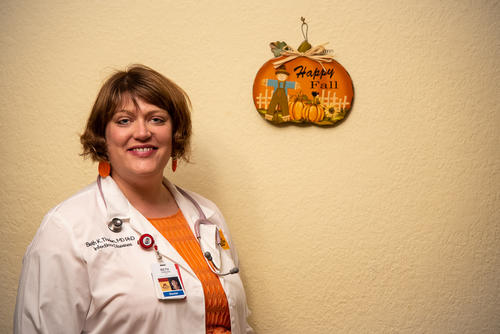
A survey by the National Retail Federation shows that more than 148 million U.S. adults plan to participate in Halloween-related activities this year, and more than three-quarters indicate the virus has impacted their plans, such as trick-or-treating.
Beth Thielen, MD, PhD, an assistant professor in the University of Minnesota Medical School and an adult and pediatric infectious diseases physician with M Health Fairview, explains how parents and community members can stay safe while celebrating Halloween during a pandemic.
Q: How are traditional Halloween activities during a pandemic a concern for Minnesotans?
Dr. Thielen: Many Halloween traditions involve activities that we know are a risk for spread of SARS-CoV-2, the virus that causes COVID-19. Trick-or-treating often involves face-to-face contact with many people and touching common items like candy buckets that can easily become contaminated with viruses. Here in Minnesota, late October means cooler weather, so we are more likely to be indoors for activities like crowded costume parties or haunted houses. For many of us, Halloween is about scary activities and screaming, which can generate more respiratory droplets that can travel farther and spread infection. And even though outdoors activities are generally safer, we have seen infections occurring when people are clustered close together outdoors in places like concerts, so even events like hayrides may be risky.
Q: How do costume masks compare to cloth masks?
Dr. Thielen: Costume masks often have holes around the nose and mouth which would allow respiratory droplets containing the SARS-CoV2 virus to pass through and be spread to other people. This year, it is recommended to wear Halloween-themed cloth masks that cover the nose and mouth.
Q: For parents, what are safe alternatives to traditional trick-or-treating?
Dr. Thielen: Many of us are disappointed that we can’t participate in traditional Halloween activities. The good news is that even though Halloween will look different this year, there are still lots of ways for families to have fun AND stay healthy. Some of the safer options include:
- Carve and decorate pumpkins with your household and sharing them outdoors at a distance with neighbors and friends.
- Plan an outdoor scavenger hunt looking for Halloween-themed items.
- Watch a halloween-themed movie remotely via Zoom, or other video sharing platform, or outdoors if physical distancing can be maintained.
- Decorate a Halloween-themed cake or cookies.
- Walk outdoors at a pumpkin patch or orchard where distance can be maintained.
Q: What can people do to help lower the risk of spreading the virus during Halloween activities?
Dr. Thielen:
- Focus on activities that can be done with members of your household or outdoors in places where physical distancing can be maintained.
- Use alcohol-based hand sanitizer or wash your hands frequently with soap and water.
- Wear a face covering over your nose and mouth when you are around people outside your household.
- If you are sharing candy or other treats, consider handing out individually wrapped “grab and go” goodie bags, rather than directly handing treats to children.
- If you plan to get together with people from outside your household, limit the size of gatherings and practice precautions for a few weeks before to avoid bringing an uninvited guest like SARS-CoV-2 to the party.
- If anyone in your household is feeling unwell, it is best to stay home to avoid spreading infection to other people. This is good advice to prevent other infections like influenza as well.
- Get vaccinated against seasonal influenza if you are able.
Q: What are gaps in our knowledge about how SARS-CoV-2 affects children?
Dr. Thielen: Multiple studies now show that children can be infected by SARS-CoV-2 and seem to get less severely ill than adults do when they are infected. We still need more studies to understand the risk of children transmitting the infection to others and understand why they are less likely to get sick. In my research laboratory, I am interested in studying the ways that different respiratory viruses interact with our immune system and how these responses differ from person-to-person based on factors like our genes and age.
- 30 -
About “Talking...with U of M”
“Talking...with U of M” is a resource whereby University of Minnesota faculty answer questions on current and other topics of general interest. Feel free to republish this content. If you would like to schedule an interview with the faculty member or have topics you’d like the University of Minnesota to explore for future “Talking...with U of M,” please contact University of Minnesota Public Relations at [email protected].
- Categories:
- Health
- Early childhood
- Population health
- COVID-19




